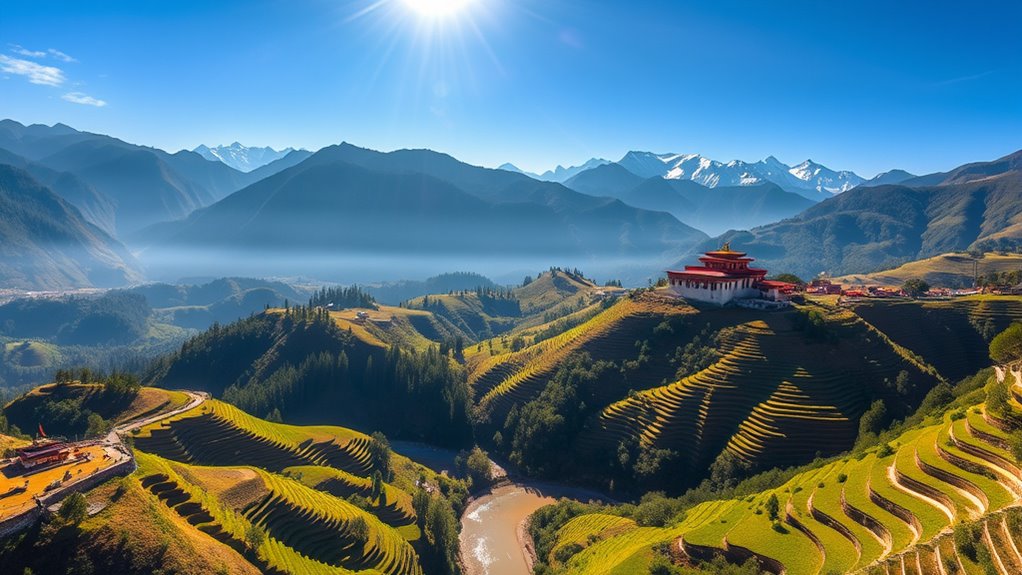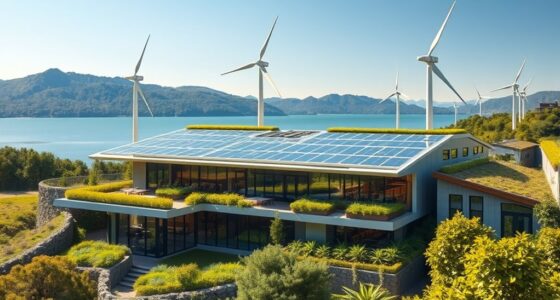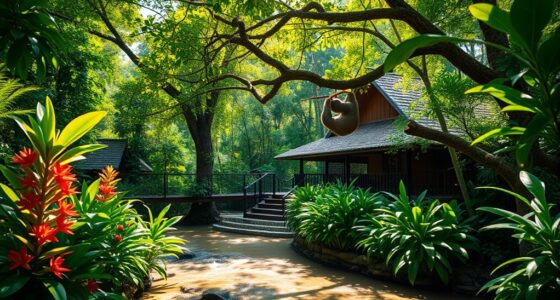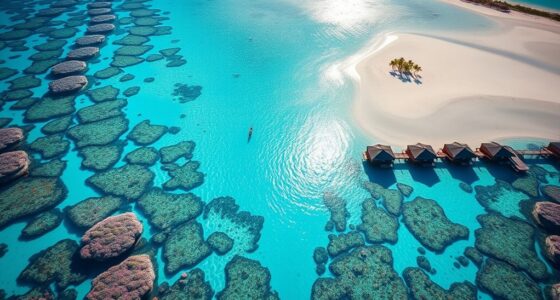In Bhutan, you’ll discover a unique blend of carbon-negative travel and cultural richness. The country balances its emissions through vast forests covering 70% of its land. With responsible tourism practices, like guided tours and eco-friendly lodging, you’ll connect with nature and locals. Bhutan’s Gross National Happiness philosophy prioritizes well-being and sustainability. Plus, innovative initiatives promote organic farming and recycling. You’ll find that Bhutan’s commitment to the environment leads to unforgettable experiences, and there’s so much more to learn.
Key Takeaways
- Bhutan achieves a net-negative carbon footprint by balancing CO2 emissions with significant forest cover, which constitutes about 70% of its land area.
- The country prioritizes high-value, low-volume tourism, ensuring minimal environmental impact while providing unique cultural experiences for visitors.
- Tourists are required to travel with guides, which helps manage visitor numbers and protects Bhutan’s natural landscapes from overcrowding.
- Eco-friendly accommodations utilize renewable energy and adhere to a no-plastic policy, contributing to sustainable travel practices.
- Bhutan’s commitment to Gross National Happiness emphasizes environmental conservation, cultural preservation, and community well-being as integral to its tourism strategy.
The Carbon Neutrality Commitment of Bhutan
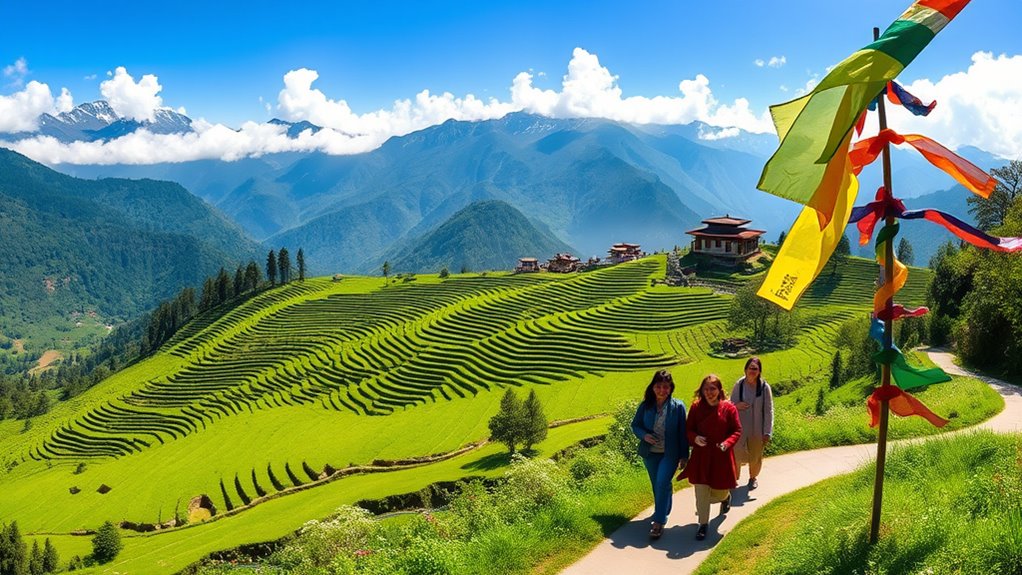
As Bhutan commits to remaining carbon neutral, it actively balances its carbon dioxide emissions with equivalent reductions or removals.
Forests cover about 70% of the country, serving as a crucial carbon sink that absorbs around 9 million tons of CO2 annually. The constitution mandates maintaining at least 60% forest cover to support this goal. 0.00% share of global GHG emissions underscores Bhutan’s unique position in the global climate landscape.
With an economy emitting roughly 2 million tons of CO2 each year, Bhutan’s efforts ensure a net-negative carbon footprint.
Bhutan’s economy emits only 2 million tons of CO2 annually, achieving a remarkable net-negative carbon footprint.
The updated Nationally Determined Contributions (NDC) highlight strategies for sustaining carbon neutrality, including the National REDD+ Strategy and low emission development practices.
These initiatives underline Bhutan’s dedication to climate resilience and responsible environmental stewardship, setting a global example for sustainable development.
Sustainable Tourism Practices
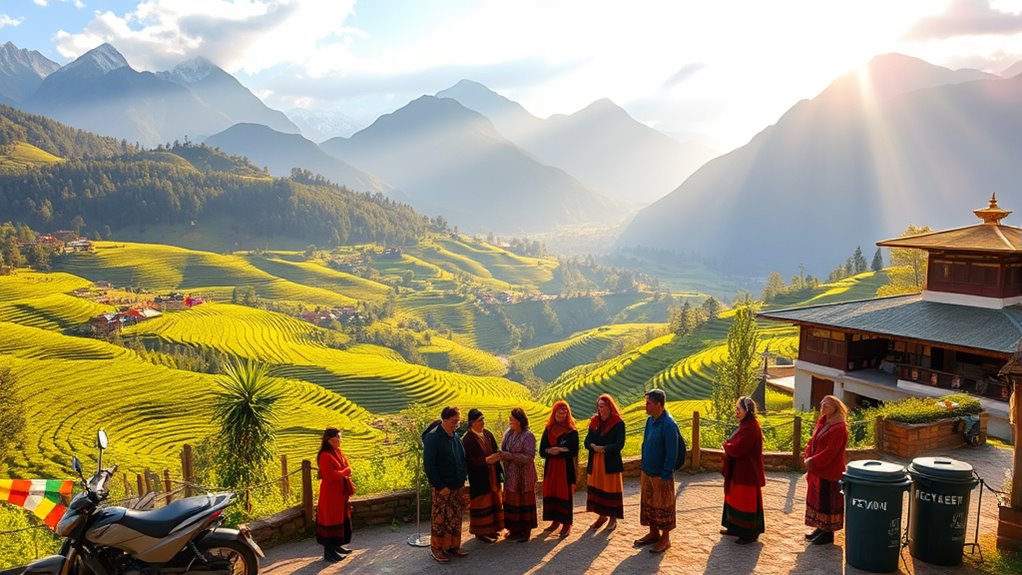
Bhutan’s commitment to carbon neutrality extends into its tourism sector, where sustainable practices play a vital role.
You’ll experience high-value, low-volume tourism, ensuring that your visit minimizes environmental impact while providing exclusive experiences. By paying a Sustainable Development Fee, you directly support conservation and community initiatives.
All tourists travel with a guide, preventing overcrowding and protecting nature. Engage in community-based tourism by staying with local families, gaining authentic insights into Bhutanese life.
Choose eco-friendly accommodations that utilize renewable energy and adhere to a no-plastic policy. Participate in conservation projects to further contribute to environmental stewardship. Additionally, be mindful of sun protection practices to ensure your outdoor activities are safe and enjoyable.
Your responsible travel choices help preserve Bhutan’s cultural and natural heritage for future generations.
The Concept of Gross National Happiness
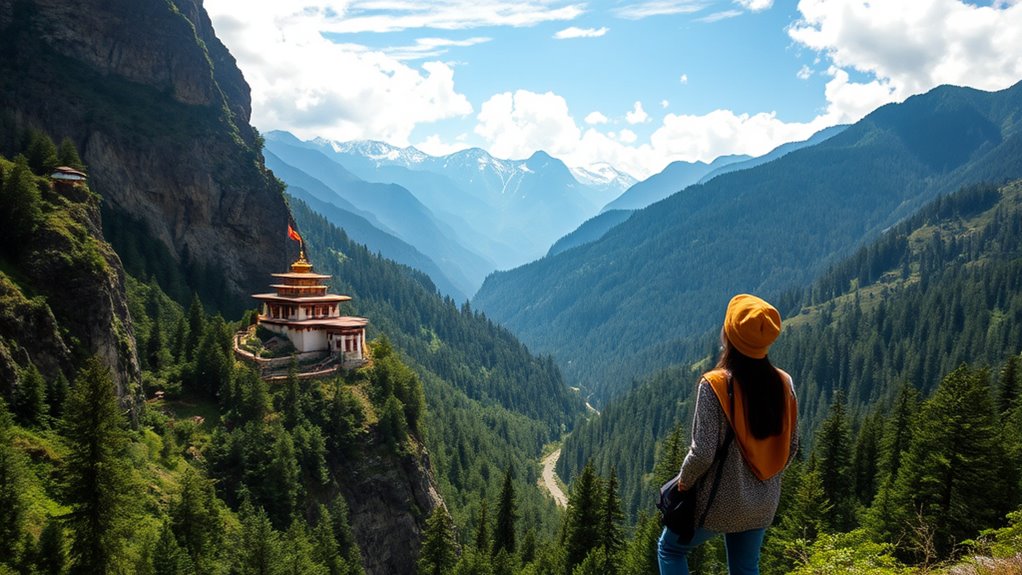
Happiness serves as a guiding principle in Bhutan’s unique approach to development, encapsulated in the concept of Gross National Happiness (GNH).
Introduced by King Jigme Singye Wangchuck in the early 1970s, GNH challenges the traditional focus on GDP, emphasizing a balanced life rooted in Buddhist principles. The Bhutanese Constitution guarantees the promotion of GNH, reflecting the nation’s commitment to happiness for all sentient beings.
GNH comprises four pillars: sustainable development, environmental conservation, cultural preservation, and good governance. It assesses psychological well-being, health, education, and ecological diversity through a comprehensive GNH Index.
Innovative Environmental Initiatives
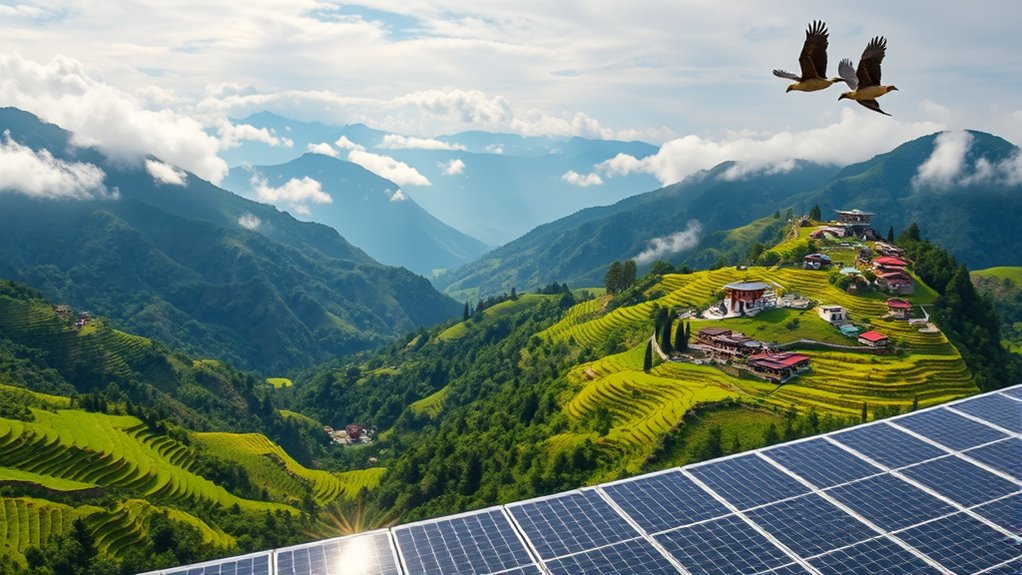
Building on the foundation of Gross National Happiness, Bhutan has embraced a range of innovative environmental initiatives that align with its commitment to sustainability and well-being.
The country predominantly generates clean energy from hydropower, exporting over 80% to neighboring nations, which significantly reduces regional emissions.
Bhutan excels in clean energy production, exporting over 80% of its hydropower and significantly lowering regional emissions.
Bhutan also emphasizes waste management through its “Reduce, Reuse, Recycle” policy, encouraging community participation and fostering a growing recycling industry.
Organic farming is promoted by regulating chemicals, ensuring healthier food options while protecting soil and water.
With over 60% forest cover mandated by its constitution, Bhutan’s conservation efforts thrive, supporting biodiversity and eco-tourism.
Cultural Preservation Efforts

While embracing modernization, Bhutan remains deeply committed to preserving its rich cultural heritage. The Ministry of Home and Cultural Affairs actively safeguards both tangible and intangible cultural elements, constructing new dzongs and maintaining historic sites.
With a new Cultural Heritage Bill on the horizon, efforts to protect buildings and the environment are gaining momentum. Traditional festivals, featuring mask dances and local rituals, play a crucial role in keeping cultural practices alive, with community engagement at their core.
The Dzongkha Development Commission promotes the national language and indigenous dialects, ensuring linguistic diversity thrives. Collaborations with international agencies like UNESCO enhance these preservation efforts, ensuring Bhutan’s cultural identity remains vibrant for future generations.
Tips for Responsible Travel in Bhutan
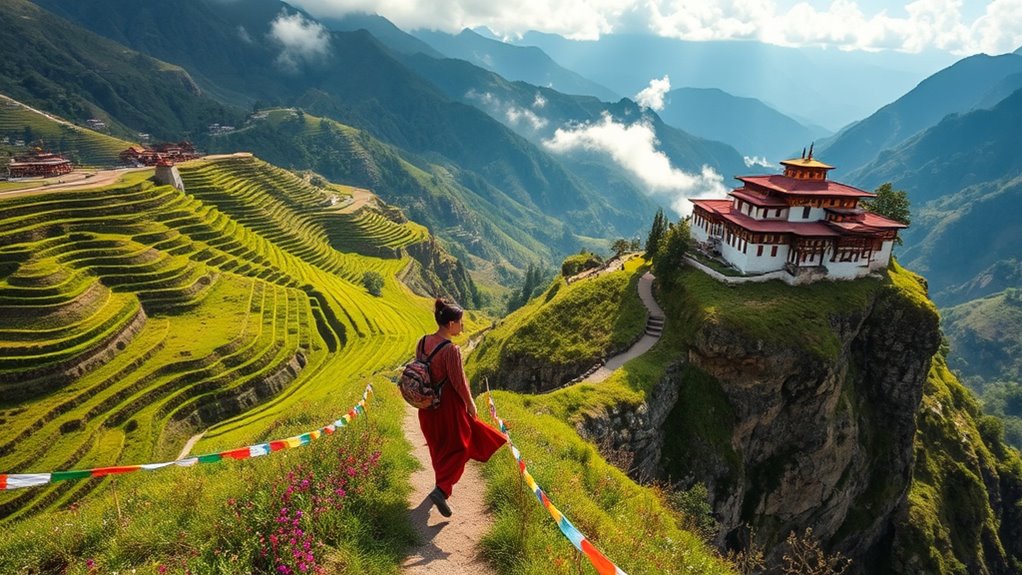
Bhutan’s commitment to cultural preservation extends to how travelers can engage with the country responsibly.
To minimize waste, ditch single-use plastics and use reusable water bottles and bags. When selecting tour operators, choose those committed to sustainable tourism policies. Support local communities by purchasing handicrafts and staying in locally-owned accommodations.
Respect nature by staying on designated trails and avoiding littering. Opt for eco-friendly hotels that utilize renewable energy. Conserve resources by using solar-powered chargers and limiting electricity use.
Embrace cultural sensitivity by dressing modestly at sacred sites and learning basic Dzongkha phrases. Finally, participate in local conservation activities, such as tree planting, to give back to Bhutan’s stunning environment while enjoying your travels.
Frequently Asked Questions
What Wildlife Species Can Be Seen in Bhutan’s National Parks?
In Bhutan’s national parks, you can spot a variety of incredible wildlife species.
Keep an eye out for Bengal tigers and snow leopards in Jigme Dorji National Park, while Royal Manas National Park is home to Indian rhinos and clouded leopards.
You might also encounter unique animals like red pandas in Bumdeling Wildlife Sanctuary and Gee’s golden langurs in Royal Manas.
Each park offers a unique glimpse into Bhutan’s diverse ecosystems and rich biodiversity.
How Can I Volunteer for Conservation Projects in Bhutan?
So, you want to save the world while sipping tea in the Himalayas, huh?
Volunteering for conservation projects in Bhutan’s a breeze! Just turn 18, grab a tourist visa, and dive into community development or wildlife care.
Connect with organizations like WWF or the Trans Bhutan Trail Team. You’ll get your hands dirty and your heart full, all while basking in Bhutan’s breathtaking beauty.
Who knew saving the planet could be this picturesque?
What Is the Best Time to Visit Bhutan for Trekking?
The best time to visit Bhutan for trekking is during the spring (March to May) and autumn (October to November).
Spring offers stunning rhododendron blooms and is perfect for lower-altitude treks.
Autumn features clear skies and vibrant foliage, ideal for high-altitude treks.
Keep in mind that weather can be unpredictable, so plan accordingly.
Consider your preferred trails and the seasonal conditions to make the most of your trekking experience in this beautiful region.
Are There Any Specific Health Precautions for Travelers in Bhutan?
When you travel to Bhutan, it’s essential to take specific health precautions.
Get vaccinations for typhoid, hepatitis A, and rabies, among others. Be mindful of mosquito-borne diseases like dengue fever; use repellents and wear protective clothing.
Stay hydrated and ascend gradually to avoid altitude sickness. Stick to bottled water and safe food practices to prevent traveler’s diarrhea.
Finally, respect local customs to ensure a smooth and enjoyable experience.
How Does Bhutan Handle Waste Management in Rural Areas?
In rural areas, Bhutan tackles waste management through community engagement and government initiatives.
You’ll notice villagers using organic waste for composting and livestock feed, while non-biodegradable items often create challenges.
The government’s developing infrastructure, including open dumps and collection systems, aims to improve waste handling.
Local health workers and teachers raise awareness, and innovative technologies like GPS and mobile apps help monitor waste, ensuring a cleaner environment for everyone.
Conclusion
In Bhutan, you’re not just visiting a stunning Himalayan kingdom; you’re stepping into a carbon-negative paradise where sustainability is a way of life. With over 72% of the country’s land covered in forest, Bhutan absorbs more carbon dioxide than it emits. By choosing to travel here, you support these incredible efforts and experience a unique culture that prioritizes happiness and environmental stewardship. So, pack your bags and embark on a journey that’s good for you and the planet!
